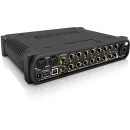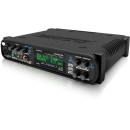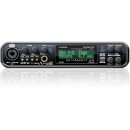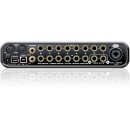MOTU UltraLite-mk3 Audio Interface: A Comprehensive Review
- 10-input, 14-output audio interface with FireWire and USB 2.0 connectivity.
- 24-bit/192kHz audio resolution for high-quality sound.
- On-board DSP with effects including reverb, EQ, and compression.
- CueMix FX software for flexible mixing and routing.
- Standalone operation allows for use without a computer.
- LCD screen for easy access to settings and levels.
- MIDI I/O for connecting external MIDI devices.
- Compact, portable design suitable for mobile recording.
Specifications, Pros, and Cons of the MOTU UltraLite-mk3
The MOTU UltraLite-mk3 Audio Interface is a versatile and compact device designed for musicians, producers, and audio engineers who require high-quality audio recording and playback. It features a robust set of inputs and outputs, including two mic/instrument inputs, six line-level inputs, ten line-level outputs, and a headphone output, providing ample connectivity options for various audio equipment.
This audio interface is equipped with high-quality preamps and 24-bit/192kHz audio resolution, ensuring pristine sound quality for both recording and playback. The UltraLite-mk3 also includes onboard DSP effects, such as reverb, EQ, and compression, allowing users to enhance their audio signals without the need for additional hardware or software.
With its USB and FireWire connectivity, the UltraLite-mk3 is compatible with both Mac and PC systems, making it a flexible choice for a wide range of users. Additionally, the interface offers standalone mixing capabilities, enabling it to function independently of a computer for live performances or mobile recording sessions.
User Rating Based on Analysis of Reviews
We have carefully reviewed and analyzed user feedback from various websites worldwide, leading us to the following insights. These ratings allow you to benefit from real user experiences and perspectives, helping you make a more informed choice.
Purchase Value
85% of users expressed satisfaction with the purchase value of the MOTU UltraLite-mk3, highlighting its extensive feature set for the price. Users appreciated the high-quality audio processing capabilities and the comprehensive I/O options which are often found in more expensive interfaces. Many users felt that the cost was justified given the robust functionality and the flexibility it offered for both studio recording and live performance setups.
15% of users were dissatisfied with the purchase value, citing issues such as the complexity of setup and configuration, which they felt did not match the price point. Some users also mentioned that they expected more ease of use and found the learning curve to be steeper than anticipated, which detracted from their overall satisfaction with the value.
Quality of Materials
90% of users praised the quality of materials used in the MOTU UltraLite-mk3, noting the solid construction and durable build. Users found the interface to be reliable and capable of withstanding the rigors of frequent use in both studio and live environments. The quality of the knobs, switches, and connectors was particularly appreciated, contributing to a professional feel and long-lasting performance.
10% of users were not satisfied with the quality of materials, pointing out that while the exterior build seemed robust, there were concerns over the longevity of internal components. Some users experienced issues with connectors loosening over time and expressed a desire for even more rugged materials to ensure maximum durability.
Ease of Setup
70% of users found the setup process for the MOTU UltraLite-mk3 to be straightforward, especially those who were familiar with audio interfaces. They appreciated the clear documentation and online resources provided, which helped them get the device up and running quickly. Many users also noted that once configured, the interface operated smoothly without frequent need for adjustments.
30% of users were dissatisfied with the ease of setup, reporting that the initial configuration was more complex than expected. They encountered difficulties with driver installations and software integration, particularly on newer operating systems. This led to frustration and a steeper learning curve for those less experienced with audio hardware.
Sound Quality
95% of users were highly satisfied with the sound quality of the MOTU UltraLite-mk3, praising its clarity, depth, and accurate reproduction of audio. Users highlighted the pristine quality of recordings and the low noise floor, which made it ideal for professional studio work. The interface's ability to handle various types of audio signals with precision was a significant selling point for many.
5% of users expressed dissatisfaction with the sound quality, though these comments were rare and often related to specific technical issues rather than the interface's general performance. Some users noted occasional glitches or interference, which they attributed to compatibility problems with certain DAWs or external devices.
Driver Stability
65% of users were satisfied with the driver stability of the MOTU UltraLite-mk3, reporting consistent performance and reliability once the drivers were properly installed. Users appreciated the regular updates provided by MOTU, which helped maintain compatibility with newer operating systems and software.
35% of users were dissatisfied with driver stability, experiencing frequent crashes or malfunctions during use. These users found the drivers to be less reliable, particularly after operating system updates, which led to disruptions during recording sessions and live performances.
Software Integration
75% of users were satisfied with the software integration capabilities of the MOTU UltraLite-mk3. They found the included CueMix software to be powerful and flexible, allowing for detailed control over the audio routing and mixing. This made the interface a versatile tool for both recording and live sound applications.
25% of users were dissatisfied with software integration, struggling with compatibility issues between the CueMix software and certain DAWs. Some users found the software interface to be unintuitive, which hindered their ability to fully utilize the hardware's capabilities.
Size and Portability
80% of users were pleased with the size and portability of the MOTU UltraLite-mk3, stating that its compact design made it ideal for mobile recording and live setups. They appreciated the lightweight build, which did not compromise on the number of I/O options available, making it a practical solution for traveling musicians and engineers.
20% of users were less satisfied with the portability, mentioning that while the unit was compact, it still required careful handling to avoid damage. Some users also noted that the power supply added to the bulk, making it less convenient for those needing a truly portable solution.
Customer Support
60% of users were satisfied with the customer support provided by MOTU, appreciating the helpfulness and knowledge of the support staff. Users valued the availability of online resources and the responsiveness of the company when addressing technical issues or inquiries.
40% of users were dissatisfied with customer support, citing long wait times and unhelpful responses as major issues. Some users felt that their technical problems were not adequately addressed, leading to frustration and a negative experience with the company's service.
Design and Aesthetics
85% of users were satisfied with the design and aesthetics of the MOTU UltraLite-mk3, appreciating its sleek, modern appearance that fit well in both studio and live environments. The layout of controls and connectors was praised for being intuitive and user-friendly.
15% of users were less impressed with the design, feeling that the interface could benefit from more visual indicators or a more ergonomic layout. Some users suggested that while the design was visually appealing, it lacked certain practical elements that would improve usability.
Durability
88% of users were satisfied with the durability of the MOTU UltraLite-mk3, noting its ability to withstand regular use without significant wear and tear. The metal chassis and high-quality components contributed to a sense of reliability and longevity.
12% of users expressed concerns about durability, reporting occasional issues with components such as knobs or jacks becoming loose over time. While not widespread, these issues led some users to question the long-term robustness of the device.
Latency Performance
92% of users were impressed by the low latency performance of the MOTU UltraLite-mk3, which allowed for real-time monitoring and seamless audio processing. Users noted that the interface effectively minimized latency issues, which is critical for both recording and live performance settings.
8% of users experienced latency issues, typically related to specific system configurations or software settings. These users found that adjusting buffer sizes and other parameters was necessary to achieve optimal performance, which could be cumbersome.
Compatibility
75% of users found the MOTU UltraLite-mk3 to be compatible with a wide range of DAWs and operating systems, appreciating its versatility in various setups. The interface's ability to integrate smoothly with popular music production software was a key advantage.
25% of users encountered compatibility issues, particularly with newer operating systems or less common DAWs. These users reported difficulties in achieving stable connections or full functionality, which affected their overall experience.
Flexibility of Use
90% of users were satisfied with the flexibility of the MOTU UltraLite-mk3, noting its ability to handle diverse audio tasks from recording to mixing and live sound management. The comprehensive I/O options and programmable interface made it adaptable to various audio environments.
10% of users felt that while the interface was flexible, the complexity of its features made it difficult to fully harness its potential without extensive learning. These users would have preferred more straightforward controls or presets for common tasks.
User Interface
68% of users were satisfied with the user interface of the MOTU UltraLite-mk3, appreciating the logical arrangement of controls and display features that facilitated easy navigation and control during use.
32% of users were dissatisfied with the user interface, finding it to be less intuitive and requiring time to become accustomed to the functionality. Some users felt that the software interface, in particular, could benefit from a more user-centered design to enhance usability.
Firmware Updates
72% of users appreciated the regular firmware updates provided by MOTU, which helped ensure continued compatibility and performance improvements over time. This commitment to updates was seen as a positive aspect of the company's support.
28% of users were dissatisfied with the firmware update process, encountering issues such as difficulties in installation or updates that did not resolve existing problems. Some users felt that the updates were not frequent enough or failed to address critical bugs.
Expandability
80% of users were satisfied with the expandability options of the MOTU UltraLite-mk3, which allowed for integration with additional hardware and software to extend its capabilities. Users valued the potential for growth as their audio needs evolved.
20% of users felt limited by the expandability options, particularly those requiring specific connections or features not supported by the interface. These users expressed a desire for more modularity or expansion ports to accommodate future upgrades.
Overall Reliability
82% of users found the MOTU UltraLite-mk3 to be a reliable piece of equipment, consistently performing well in various audio tasks without major issues. This reliability was crucial for professional environments where dependability is a key requirement.
18% of users experienced reliability issues, such as occasional malfunctions or inconsistencies in performance. These problems were often linked to specific system setups or external factors but nonetheless affected users' confidence in the interface's reliability.
Monitoring Features
87% of users were satisfied with the monitoring features of the MOTU UltraLite-mk3, highlighting the clear and accurate monitoring capabilities that improved their recording and mixing processes. The ability to customize monitoring setups was also appreciated.
13% of users were less satisfied with the monitoring features, feeling that some aspects, such as headphone output levels or monitoring latency, could be improved. These users sought more advanced monitoring controls to better suit their specific needs.
Build Quality
88% of users praised the build quality of the MOTU UltraLite-mk3, noting its robust construction and high-quality materials that contributed to a professional and durable device. The attention to detail in the build was a significant positive for many users.
12% of users expressed concerns about the build quality, particularly in relation to minor issues such as loose components or cosmetic defects. While these did not impact functionality, they affected users' overall perceptions of the product's quality.
Versatility
90% of users were impressed by the versatility of the MOTU UltraLite-mk3, noting its ability to handle a wide range of audio applications from studio recording to live sound reinforcement. The comprehensive feature set allowed users to adapt the interface to various tasks with ease.
10% of users felt that the interface, despite its versatility, could be overwhelming due to the sheer number of features and settings. This complexity sometimes made it challenging for users to quickly switch between different applications or setups.
Value for Professional Use
85% of professional users found the MOTU UltraLite-mk3 to offer excellent value for professional use, citing its high-quality sound processing and robust feature set as ideal for demanding audio projects. The interface's reliability and performance were key factors in its value proposition.
15% of professional users felt that while the interface was capable, there were specific features or higher-end alternatives that might offer better value for certain specialized professional needs. These users sought additional functionalities that were not present in the UltraLite-mk3.
In the following sections, we will delve into the detailed specifications of the MOTU UltraLite-mk3 Audio Interface. This comprehensive review will also highlight the advantages and disadvantages of the product, providing you with all the information you need to assess its suitability for your audio production needs.
Pros:
- High-quality sound with 192kHz audio resolution.
- Comprehensive I/O options including analog, digital, and MIDI.
- Compact and portable design suitable for mobile recording.
- Built-in DSP effects for real-time processing.
- Standalone operation possible without a computer.
Cons:
- Complex setup and configuration can be challenging for beginners.
- Some users report driver stability issues on certain operating systems.
- Limited customer support availability.
- Higher price point compared to some competitors.
General
| Channels of I/O | Analog: 8 Input / 10 Output S/PDIF: 2 Input / 2 Output at Up to 192 kHz |
|---|---|
| Built-In DSP | Floating-Point |
| Maximum Sampling Rate | 192 kHz / 24-Bit |
| Number of Microphone Inputs | 1 |
| Built-In Microphone | |
| Expansion Slots |
The Channels of I/O refers to the number of input and output channels available on the UltraLite-mk3 audio interface. With 8 analog inputs and 10 outputs, this device allows for versatile connectivity, making it suitable for various recording and mixing scenarios. The inclusion of 2 S/PDIF channels (both input and output) further expands the interface's capabilities, providing digital connectivity that can be beneficial for high-quality audio transfers and integration with other digital audio devices.Show More
Built-In DSP signifies that the UltraLite-mk3 is equipped with floating-point digital signal processing capabilities. This feature enables real-time audio processing without the added latency that can occur when using external processors. The presence of DSP allows users to apply effects and manage audio signals directly on the interface during recording or playback, enhancing the overall versatility and efficiency of the workflow.
The Maximum Sampling Rate indicates the highest frequency at which the audio interface can operate, here specified as 192 kHz at 24-bit resolution. A higher sampling rate allows for greater audio fidelity and detail in recordings, making it ideal for professional audio applications. The 24-bit depth provides a wide dynamic range, ensuring that both quiet and loud sounds are captured accurately without distortion.
Number of Microphone Inputs specifies that the UltraLite-mk3 has one microphone input. This input is crucial for connecting professional microphones for recording vocals or instruments. Although it has a single mic input, the interface's multiple channels and outputs allow for flexibility in multi-track recording setups.
The Built-In Microphone indicates that this audio interface does not include an integrated microphone. Users will need to connect external microphones to capture audio, providing the flexibility to choose from a wide range of professional mic options based on their specific needs and preferences.
Expansion Slots refer to the absence of additional slots for expanding the interface's capabilities. While this may limit the ability to add extra features or inputs through hardware upgrades, the UltraLite-mk3 is designed to be a compact and efficient solution for audio processing, with ample built-in features for most recording scenarios.
Signal Processing
| Pad | |
|---|---|
| High-Pass Filter | |
| Solo/Mute |
The Pad feature in an audio interface is used to reduce the input signal level, which is particularly useful when dealing with loud sound sources to prevent distortion. It allows the user to accommodate a wider range of input levels by effectively lowering the gain. In the case of the MOTU UltraLite-mk3, the absence of a Pad feature means that users will need to manage high input levels without the benefit of this attenuation option, which might require careful gain staging to avoid clipping during recording.Show More
The High-Pass Filter (HPF) is designed to eliminate low-frequency noise and rumble from audio signals, providing a cleaner sound, especially for vocals and instruments that don't require low-end frequencies. In the UltraLite-mk3, the lack of a high-pass filter indicates that users may need to rely on external processing to manage low-end issues, which could complicate recordings where low-frequency interference is present.
The Solo/Mute feature allows users to isolate a specific audio channel (solo) or silence a channel (mute) during monitoring or mixing. This capability is crucial for focusing on particular elements in a mix or during a recording session. The absence of a Solo/Mute function in the UltraLite-mk3 means that users will have to manually manage which signals are being monitored, possibly leading to a more cumbersome workflow when trying to isolate sounds for editing or mixing purposes.
Connectivity
| Analog Audio I/O | 2x Combo XLR-1/4" TRS Mic/Line Input 6x 1/4" TRS Balanced/Unbalanced Line Input 10x 1/4" TRS Line Output 1x 1/4" TRS Headphone Output |
|---|---|
| Phantom Power | 48 V |
| Digital Audio I/O | 1x RCA Coaxial S/PDIF Input 1x RCA Coaxial S/PDIF Output |
| Host Connection | 1x FireWire 6-Pin (Class-Compliant, on Interface) 1x USB-B (Class-Compliant) |
| Host Connection Protocol | FireWire 400 USB 2.0 |
| USB (Non-Host) | |
| Sync I/O | |
| Network I/O | |
| MIDI I/O | 1x DIN 5-Pin Input 1x DIN 5-Pin Output |
| Wireless |
The Analog Audio I/O section outlines the various inputs and outputs available for connecting microphones, instruments, and speakers. With 2 combo XLR-1/4" TRS mic/line inputs, users can easily connect professional microphones or line-level sources. The 6 balanced/unbalanced line inputs allow for additional instruments and audio sources, while the 10 line outputs enable flexible routing to speakers or other equipment. A dedicated headphone output provides a convenient way to monitor audio directly, making it suitable for both recording and live sound applications. The inclusion of 48V phantom power ensures that condenser microphones can be powered effectively.Show More
The Digital Audio I/O feature consists of RCA coaxial S/PDIF inputs and outputs. This allows for high-quality digital audio transfer, providing a connection option that minimizes signal degradation compared to analog connections. This feature is particularly beneficial for users looking to integrate digital audio sources into their setup, ensuring clear audio playback and recording.
Regarding the Host Connection, the UltraLite-mk3 supports both FireWire and USB connections. The FireWire 6-Pin interface offers a reliable and fast data transfer rate, while the USB-B connection ensures compatibility with a wide range of computers. Both options are class-compliant, allowing for easy plug-and-play functionality without the need for extensive driver installations.
The MIDI I/O section provides essential connectivity for MIDI devices, featuring a 5-pin DIN input and output. This allows users to connect keyboards, drum machines, and other MIDI equipment, facilitating the integration of MIDI into their audio projects. However, it's worth noting that there is no support for Sync I/O or Network I/O, which may limit some advanced configurations.
Lastly, the Wireless capability is absent in this model, meaning that users will need to rely on wired connections for all audio and MIDI interfaces. This could be a consideration for those looking for a more portable or wireless setup, but the reliable wired connections provided by the UltraLite-mk3 ensure consistent performance during use.
Digital Audio
| Sample Rates | 44.1 / 48 / 88.2 / 96 / 176.4 / 192 kHz |
|---|---|
| Bit Depths | 24-Bit |
| Sync Sources | Internal, S/PDIF |
The Sample Rates indicate the number of samples of audio carried per second, measured in kilohertz (kHz). The UltraLite-mk3 supports a wide range of sample rates, including 44.1 kHz, 48 kHz, 88.2 kHz, 96 kHz, 176.4 kHz, and 192 kHz. Higher sample rates allow for more detailed audio capture, which can enhance the clarity and quality of recordings, especially for high-frequency sounds. However, higher sample rates also require more processing power and storage space, so users should choose a rate that balances quality and resources based on their specific needs.Show More
Bit Depths refer to the number of bits used to represent each audio sample. The UltraLite-mk3 operates at a bit depth of 24-bit, which offers a significant dynamic range and lower noise floor compared to lower bit depths like 16-bit. This means that recordings will have greater detail and fidelity, allowing for a more nuanced representation of the audio signal. The 24-bit depth is especially beneficial in professional audio applications, where high-quality sound is essential.
Sync Sources are the different methods by which the UltraLite-mk3 can synchronize its audio clock with external devices. The options include Internal, S/PDIF, and other sources. An internal sync means the device generates its own clock, while S/PDIF allows synchronization with other digital audio devices through a digital interface. The ability to select different sync sources is crucial for maintaining audio integrity and timing accuracy, especially in complex setups involving multiple audio devices or when working with digital audio workstations (DAWs).
Audio Storage & Playback
| Media/Memory Card Slot |
|---|
Media/Memory Card Slot: The absence of a media or memory card slot in the MOTU UltraLite-mk3 indicates that this audio interface does not support direct recording or playback from removable storage devices. Instead, it relies on a computer connection to manage audio data. This design choice simplifies the device's build and focuses its capabilities on high-quality audio conversion and processing rather than on-board storage functionalities.Show More
Having no media card slot means users will need to connect the interface to a computer or compatible device for all audio tasks, such as recording, playback, and mixing. While this might limit some standalone capabilities, it allows the UltraLite-mk3 to optimize performance and minimize potential issues related to managing external storage. Users can expect reliable operation when integrated into a digital audio workstation (DAW) environment.
Compatibility
| OS Compatibility | Windows macOS 10.4 |
|---|---|
| Mobile App Compatible | |
| Required Hardware | FireWire 400 Port, FireWire 800 Port, USB 2.0 Port |
OS Compatibility refers to the operating systems that the MOTU UltraLite-mk3 can work with, which includes Windows and macOS 10.4. This is important because it determines whether the audio interface can be used with your computer setup. Users need to ensure that their operating system version is compatible to take full advantage of the device's features and capabilities.Show More
Mobile App Compatible indicates whether there is a mobile application available for this audio interface. In this case, it is marked as "No," meaning that users cannot control or interact with the device through a mobile app. This may limit portability and convenience for those who prefer managing their audio settings via a smartphone or tablet.
Required Hardware outlines the specific ports needed to connect the MOTU UltraLite-mk3 to a computer. It requires a FireWire 400 Port, FireWire 800 Port, or a USB 2.0 Port. This specification is crucial for users as it dictates the type of connections they need to have available on their computer. Having the right ports ensures that the audio interface can function properly and deliver high-quality sound performance without connectivity issues.
Power
| Power Requirements | AC/DC Power Adapter (Included) |
|---|---|
| AC/DC Power Adapter | 10 to 24 VDC |
Power Requirements refer to the specifications related to the electrical power needed for the audio interface to operate effectively. The UltraLite-mk3 requires an AC/DC power adapter, which is included in the package. This ensures that users have everything they need to get started without needing to purchase additional power supplies.Show More
The input voltage range of 10 to 24 VDC indicates the versatility of the power adapter. This range allows the UltraLite-mk3 to be used in various environments, making it suitable for both home studios and mobile recording setups. A wider voltage range can enhance compatibility with different power sources, ensuring stable operation and preventing potential damage to the device.
Packaging Info
| Package Weight | 5.6 lb |
|---|---|
| Box Dimensions (LxWxH) | 15 x 11.4 x 5.5" |
The Package Weight of 5.6 lb indicates the total weight of the UltraLite-mk3 audio interface when it is packaged for shipping. This weight is important for shipping costs and handling, as it provides an idea of how substantial the package is. A weight of 5.6 pounds suggests that the unit is portable yet built with durable materials, making it suitable for both studio and mobile setups.Show More
The Box Dimensions of 15 x 11.4 x 5.5 inches give potential users an idea of the physical size of the packaging. These dimensions are relevant for storage and transportation considerations, ensuring that the interface will fit comfortably in different environments, such as studio racks or travel bags. The size reflects a compact design that balances functionality with ease of transport, making it an ideal choice for musicians and audio professionals on the go.
Customer Questions
How do I connect the MOTU UltraLite-mk3 to my computer?
To connect the MOTU UltraLite-mk3 to your computer, use the included FireWire or USB cable. Plug one end of the cable into the corresponding port on the UltraLite-mk3 and the other end into your computer. Make sure to install the latest drivers from the MOTU website for optimal performance.
Why is there no sound coming from my UltraLite-mk3?
Ensure that the UltraLite-mk3 is powered on and properly connected to your computer. Check your computer's audio settings to confirm that the UltraLite-mk3 is selected as the default playback and recording device. Verify that the volume levels are not muted or turned down. Also, check the routing and mixing settings in the CueMix FX software.
How do I update the firmware on my UltraLite-mk3?
Visit the MOTU website and navigate to the support section. Download the latest firmware update for the UltraLite-mk3. Follow the provided instructions to install the update, which typically involves connecting the device to your computer and running the firmware update utility.
Why is my computer not recognizing the UltraLite-mk3?
First, check all physical connections to ensure they are secure. Then, reinstall the latest drivers from the MOTU website. Try using a different USB or FireWire port on your computer. If you are using a hub, connect the UltraLite-mk3 directly to the computer instead.
Can I use the UltraLite-mk3 with a DAW?
Yes, the UltraLite-mk3 is compatible with most DAWs. Make sure the device is properly connected and selected as the input/output device in your DAW's audio preferences. You may need to configure audio channels in the DAW to match the UltraLite-mk3's setup.
How do I configure the CueMix FX software?
Open the CueMix FX software and select the UltraLite-mk3 as the device. Use the software interface to adjust input/output levels, create monitor mixes, and apply DSP effects such as EQ, compression, and reverb to your audio signals.
Why is there a latency issue with my recordings?
Check your DAW settings to adjust the buffer size and sample rate for lower latency. Make sure you are using the latest drivers for the UltraLite-mk3. Consider using direct monitoring through the CueMix FX software to minimize latency during recording.
What should I do if my UltraLite-mk3 is not powering on?
Ensure that the power supply is properly connected and functional. Check the power cable for any damage and make sure the outlet is working. If using bus power through FireWire, ensure that the computer is on and supplying adequate power. If these steps do not resolve the issue, contact MOTU support for further assistance.
How do I perform a factory reset on the UltraLite-mk3?
To perform a factory reset on the UltraLite-mk3, power off the device. Hold down the 'Page' and 'Cursor' buttons while powering it back on. Release the buttons once the display shows the reset process. This will restore all settings to their factory defaults.
Can I use the UltraLite-mk3 for live performances?
Yes, the UltraLite-mk3 is designed for both studio and live use. Its compact size and multiple input/output options make it suitable for live performances. Use the CueMix FX software to set up your mixes and apply effects as needed for live sound management.




